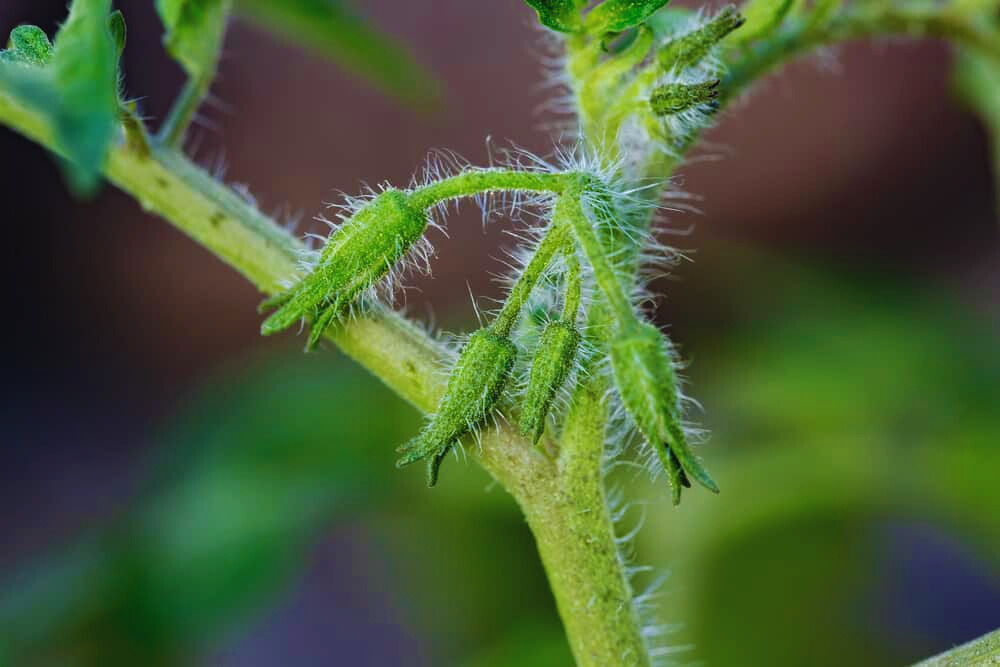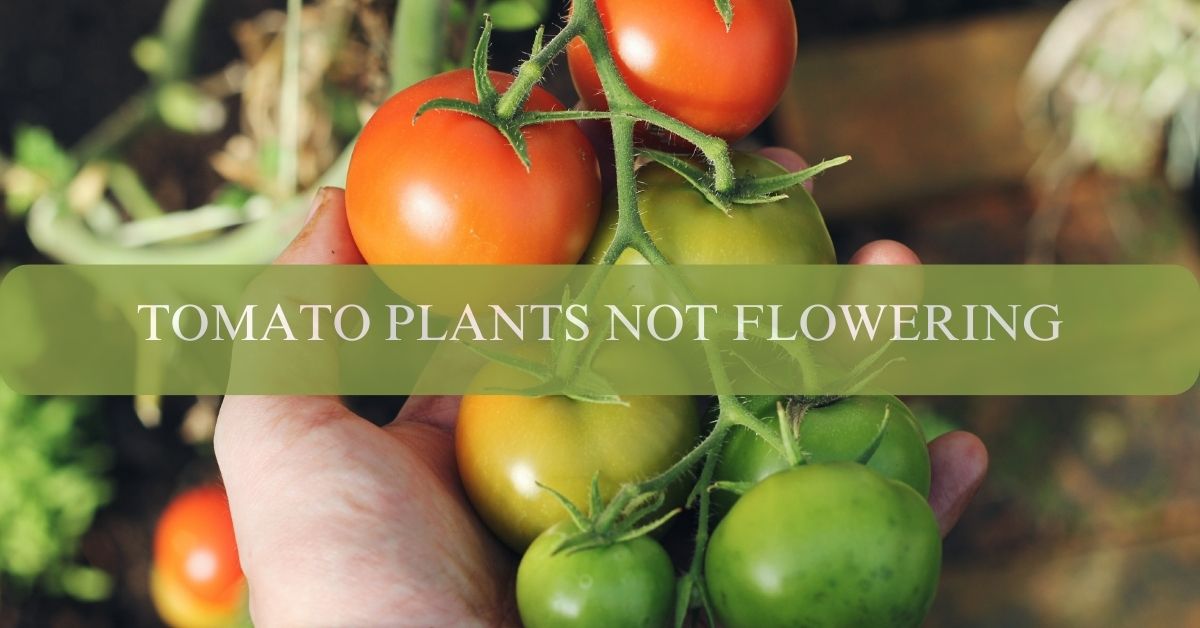Do you love gardening and are struggling to make your tomato plants flower? Don’t worry; we will help you solve this issue!
Tomato plants not flowering is a common issue that gardeners face. Seeing your plants grow tall and green but not produce any fruit can be frustrating. But why is this happening? What can you do to fix it?
In this blog, we’ll discuss why tomato plants are not flowering and provide some practical solutions to help you get your plants blooming again.

Why Is My Tomato Plant Not Flowering?
There are a few common reasons your tomato plants may not produce blossoms. Some of the most common causes include:
1. Disease
One of the major factors that may be affecting your tomato plant’s ability to flower is disease. Diseases like fusarium wilt, verticillium wilt, and bacterial canker can all impact the health and growth of your plant. If your tomato plant is affected by a disease, it may lose its reproduction ability hence no blossoms or fruit.
To prevent the disease from affecting your plants, make sure to practice good garden hygiene. This includes regularly removing dead or diseased plant material, avoiding overhead watering, and rotating crops every season.
2. Nutrition
Nutrition deficiency can be another factor that may stop your tomato plant from flowering. Providing your tomato plants with proper nutrition is essential for healthy growth and flower production. Tomato plants require various nutrients to produce fruits, like nitrogen, potassium, calcium, magnesium, phosphorus, and sulfur, to name a few.
To ensure your tomato plants get all the necessary nutrients, consider adding organic matter like compost or aged manure to the soil. You can also use a balanced fertilizer specifically formulated for tomatoes. Fertilizing your plants regularly can make your tomato plant thrive and produce a bounty of fruits.
Another option is to use natural sources of nutrients, such as fish emulsion or bone meal. Just be sure to follow the instructions on the package carefully, as overuse can damage your plants.
3. Genetics
It’s worth considering the genetics of your tomato plants. Some tomato varieties are naturally more prone to flowering and fruiting than others. So when choosing which tomato plants to grow, research to find types known for their strong flower production and yields.
Additionally, if you are saving seeds from your own tomato plants, remember that the genetics of those plants can be unpredictable. Over time, certain traits may become more or less dominant, which can impact flower production and other aspects of plant growth.
Generally, buying high-quality seeds from reputable sources is best to ensure maximum fruit quality.
4. Pollination
Another critical factor that affects the ability of tomato plants to produce flowers is pollination. Pollination is the process of transferring pollen from one plant to another. This process leads to fertilization and the formation of fruits.
Many tomato plants don’t need external help to fertilize their flowers as they can self-pollinate. Nevertheless, certain tomato plants need bees or other insects for cross-pollination to bear fruit.
You can help your tomato plants by attracting bees and other pollinators to your garden. You can do this by offering a water source, like a bird bath or shallow dish, and planting flowers attractive to bees, like lavender or marigolds.
Another way to promote pollination is to shake the tomato plants to release the pollen gently. Using a cotton swab or brush, you can also transfer pollen from flower to flower.
5. Temperatures
Temperature is another significant factor that can affect tomato plants’ flowering and fruit production. Tomatoes thrive in warm temperatures ranging from 70-80F during the day and 60-70F at night.
However, excessive heat or cold can interfere with flower development and pollination. For example, if temperatures rise above 90F, pollen may become sterile, resulting in a poor fruit set. Therefore, if the temperature goes below 50F, the plant may get shocked, leading to less growth and reduced fruiting.
To ensure optimal temperature conditions for your tomato plants, plan your planting schedule according to your region’s climate and avoid exposing your plants to extreme temperatures. You can also use shade cloth or row covers to protect your plants from excessive heat or cold.
Do I Have To Get Rid Of Diseased Tomato Plants?
Yes, if the disease is severe and chances are spreading to other plants, immediately get rid of it. However, if the disease is mild or localized, you may be able to save the plant with proper treatment. This may involve pruning off affected leaves or spraying with an organic fungicide.
What Happens If A Tomato Plant Is Not Flowering?
Tomato plants not flowering can contribute to many factors, as mentioned above. Addressing any nutrient deficiencies, ensuring proper pollination, selecting the right tomato varieties, and regulating temperature can all significantly encourage flower production.
However, if you have addressed these factors and your plant still isn’t producing flowers, it may be experiencing other issues, such as disease or pests. Checking regularly for any signs of damage or infestations and taking appropriate action can help your plant recover and resume its natural growth cycle.
How Do I Get My Tomato Plant To Flower?
Seeing your grown plant flowering is always exciting, but sometimes it just needs that extra push. So here are some tips to help your tomato plants flower:
1. Ensure optimal growing conditions: As mentioned earlier, factors like genetics, pollination, and temperature can all impact the flowering of your tomato plants. Therefore, ensure you provide everything your plant needs to start blooming.
2. Prune your plants: Removing excess foliage from your tomato plants can help redirect their energy toward flower and fruit production. Be sure to use clean, sharp pruning shears, and only remove the necessary branches and leaves.
3. Use fertilizer: A balanced fertilizer high in phosphorus can help encourage your tomato plants to start flowering. However, follow the instructions on the label carefully, and avoid over-fertilizing, as this can lead to nutrient burn and other issues.
4. Try hand pollination: If your tomato plants aren’t self-pollinating, you may need to take matters into your own hands (literally). To help fertilize the female flowers, use a small brush or cotton swab to gently transfer pollen from the male flowers.
You can help your tomato plants produce beautiful, flavorful flowers with patience and care. Just remember to keep an eye on your plants and address any issues that arise promptly, and you’ll be enjoying fresh tomatoes in no time.
How To Increase Flowering In Tomatoes
Increasing flowing in your tomato plant can be done in various ways. Here are some tips to help promote healthy flower growth:
1. Adjust watering: Over or under-watering your tomato plants can cause stress, which may lead to slower or reduced flowering. Instead, ensure your plants receive the right amount of water based on their growth stage and climate conditions.
2. Use companion planting: Certain companion plants, such as marigolds, can help attract beneficial insects and improve pollination. Consider planting these alongside your tomato plants to help boost their overall health and flower production.
3. Provide support: Tomato plants with proper support, such as stakes or cages, are less likely to become stressed or damaged, which can impact flowering. Make sure your plants have adequate support to prevent them from falling over or bending.
4. Use natural remedies: Certain natural remedies, such as compost tea or Epsom salt, can help improve soil and plant health, which may result in increased flowering. However, always follow instructions carefully and avoid using any remedies that may harm your plants or the environment.
Why Are My Tomato Plants Flowering But Not Producing Fruit?
While tomato plants usually produce flowers before fruit, the presence of flowers doesn’t guarantee that your plant will produce a bountiful harvest. Pollination, genetics, and environmental factors can all affect whether your tomato plant will ultimately produce fruit. So be sure you take care of those things if you want your tomato plant to produce fruit.
FAQ
What Triggers Flowering In Tomato Plants?
Flowering in tomato plants can be triggered by multiple factors, including genetics, pollination, temperature, and nutrition. Tomatoes typically require at least eight hours of sunlight daily to initiate flowering. Additionally, proper nutrition is crucial for healthy tomato plant growth and flower development.
What Kind Of Fertilizer Do You Use For Tomatoes?
When fertilizing tomato plants, a balanced fertilizer with a higher amount of phosphorus is recommended. Phosphorus is essential for flower and fruit development, so a fertilizer with a higher amount of this nutrient can help promote healthy flowering in your tomato plants.
How Long Does It Take For Tomatoes To Flower?
The time it takes can vary depending on factors such as the variety of tomatoes and growing conditions. However, most tomato plants will start flowering around 6-8 weeks after being transplanted or planted from seed.
Do Tomatoes Flower Multiple Times?
Yes, tomato plants can produce flowers multiple times throughout the growing season if they receive proper care and ideal growing conditions.
Do Tomatoes Flower Automatically?
Tomato plants do not flower automatically. As mentioned earlier, several factors must be in place and functioning correctly to trigger flower development, such as genetics, pollination, and temperature. If any of these factors are off, it can delay or inhibit flowering.
Conclusion
Getting your tomato plants to flower and produce delicious fruit requires some knowledge and effort, but the results are well worth it. Providing the right nutrients, watering, and support, promoting pollination, and removing spent flowers can all help encourage healthy and abundant flowering throughout the growing season. In addition, you can enjoy a bountiful harvest of juicy, flavorful tomatoes by staying attentive to your plants’ needs and practicing good gardening practices.


